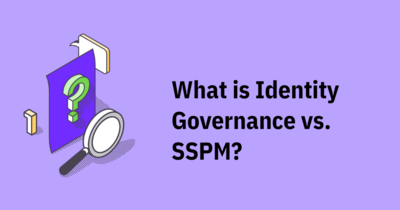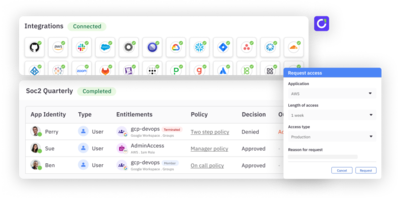Identity Governance and SaaS Security Posture Management (SSPM) are two related but distinct concepts within the field of information security.
What is Identity Governance?
Identity Governance refers to the process of managing access to resources within an organization. This involves defining identities and managing authentication, authorization, and accountability for all users and systems. The goal of identity governance is to ensure that only the right people have access to the right information and resources at the right time, while ensuring compliance with internal policies and external regulations.
Identity governance is the policy-based orchestration between identity management and access control that acts as a security function to makes sure identities are properly and securely connected to applications, networks, data, and other IT resources when needed.
What is SaaS Security Posture Management (SSPM)?
SaaS Security Posture Management (SSPM) is the practice of managing the security posture of software-as-a-service (SaaS) applications. This involves assessing, monitoring, and controlling the security risks associated with using SaaS applications.
A SaaS security posture refers to the overall security stance of a SaaS application and its underlying infrastructure. It includes the security controls and mechanisms put in place to protect the application and its data from various threats such as cyber attacks, data breaches, and unauthorized access.
SaaS security posture management involves a variety of activities, including:
- Risk assessment: identifying potential security risks associated with using SaaS applications and assessing their impact.
- Security controls: implementing security controls and measures to reduce the risk of security incidents, such as encryption, access controls, and data backups.
- Monitoring: continuously monitoring the SaaS application for security incidents, vulnerabilities, and compliance with security policies.
- Incident response: having a plan in place to respond to security incidents and breaches if they occur.
- Compliance: ensuring that the SaaS application complies with relevant security regulations and standards.
SaaS security posture management is essential for businesses that use SaaS applications, as it helps to mitigate security risks and ensure the confidentiality, integrity, and availability of data.
How are Identity Governance and SSPM similar?
Identity governance and SaaS security posture management are two different areas of security management, but they do have some similarities. Both are aimed at protecting sensitive data and reducing security risks. SSPM focuses on protecting SaaS applications and the data stored in them, while identity governance focuses on managing access to data and applications.
In both cases, it is important to have a clear understanding of the risks involved and how to implement appropriate controls in order to reduce those risks. Both areas also need an ongoing assessment and adjustment of security measures to ensure that they are effective and up to date. Both SSPM and identity governance can also involve compliance with various security and privacy regulations, such as GDPR, HIPAA, and PCI-DSS.
While there are some similarities between identity governance and SSPM, they are distinct areas of security management that require their own specific approaches and strategies.
Summary
Identity governance and SSPM are both important areas in security management, but identity governance focuses on the protection of data and reducing outside risk through identity management and access controls, while SSPM focuses on protecting SaaS applications themselves and the information within them. Both are crucial components for increasing security posture and for decreasing the risk for breaches and malpractice.


